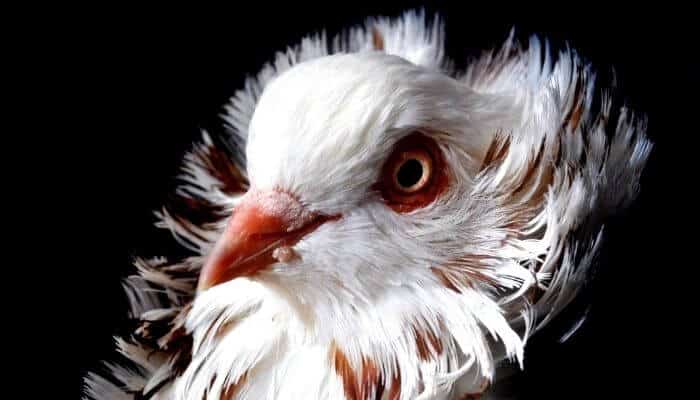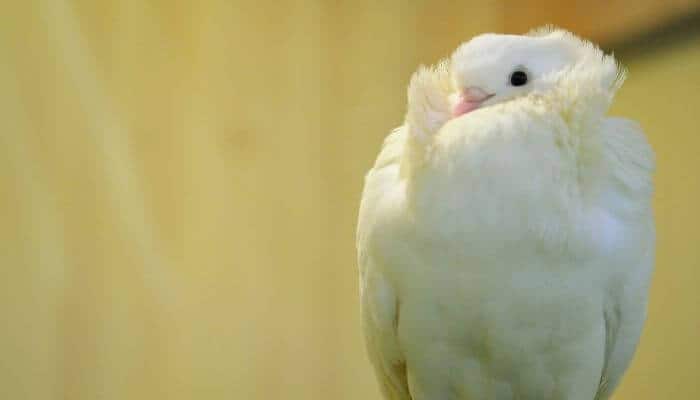The Old Dutch Capuchine pigeon is a breed of fancy pigeon known for its distinctive head crest and hood. It is kept for ornamental and exhibition purposes and makes a good pet.
Origins of the Old Dutch Capuchine Pigeon
As the name suggests, the Old Dutch Capuchine pigeon was developed in its current form in The Netherlands.
It is not native to The Netherlands, and it is believed that the deeper origins of the breed date back to India and the Middle East, where Dutch sailors discovered the birds and brought them back to their homeland in the 1500s.

There is confidence in this history because this breed of pigeon is seen depicted in some Old Dutch Master paintings from the early 16th century.
It is also known to be of continuing popularity in the Low Countries much later as Old Dutch Capuchines appear in a number of paintings by Belgian artist Henri Voordecker (1779 to 1861).
The breed can be seen in the Boy and Girl With Their Pigeons in a Loft.
The Pigeons painting was presented as a birthday gift by Queen Victoria to Prince Albert in 1841.
Distribution And Habitat of the Old Dutch Capuchine Pigeon
The Old Dutch Capuchine pigeon is a bird that can be raised in pretty much any part of the world.
The breed remains very popular in its native Netherlands, Germany and is also particularly popular in Malaysia and Singapore!
It was first imported to the United Kingdom in the late 1950s/early 1960s and the United States sometime in the 1960s, and it remains a popular choice with both countries having national Old Dutch Capuchine societies.
Old Dutch Capuchine Pigeon Appearance
| Wingspan | Length | Weight | Colouring | |
| Adult Old Dutch Capuchine Pigeon | 60 – 70 cm | 28 – 32 cm | 310 – 370 g | Yellow, white, red, and black, tiger and barred. |
| Typical Feral Pigeon | 64 – 72 cm | 32 – 37cm | 300 – 500 g | Bluish grey with some black. |
The Old Dutch Capuchine pigeon is a small to medium-sized bird.
The body is ideally carried horizontally. They have well-rounded heads that are broad at the back. The beaks are of a medium length with a slight curve at the tip.
Necks taper to a broad, full breast that should protrude beyond the end of the beak when in an upright stance and a back that is broad from the shoulders.
The breed’s lively eyes are pearl white and cere are of fine texture and flesh to red coloured.
Wings lie high up on the body, are tightly feathered and should finish about 1cm before the end of the tail which is relatively short compared to body length.
Legs are bright red, and the breed standard is for legs and toes to be featherless.

The most striking feature of the Old Dutch Capuchine pigeon is the hood/ruff of feathers around the neck area. The hood is made more profound by elliptically shaped rosettes on either side of the neck.
To some people, these ornamental feathers resemble a fabulous feather boa, but they might also have given rise to the breed’s name.
The feathers grow in the shape of a hood, similar to the Jacobin Pigeon, this resembles the cowl of the robes worn by capuchin monks, cappuccio is the word for hood in Italian.
Old Dutch Capuchine pigeons can be bred in a number of different colours including black, yellow and red, with a variety of bars including red, yellow and black and also in patterns described as tiger.
On average, the weight of a mature Old Dutch Capuchine pigeon tends to be in the region of 310 and 370 grams.
Character of the Old Dutch Capuchine
Alongside striking looks, the Old Dutch Capuchine pigeon has a very appealing temperament.
They have a strong reputation for being birds with very relaxed attitudes that have a lot of natural grace, and for this reason, they are regarded by many as being ideal for pets and beginners in the world of pigeon fancying.
No particularly special behavioural training is needed for an Old Dutch Capuchine pigeon outside of the norm, making them great for those without the extensive experience needed to raise other more complicated breeds.
Old Dutch Capuchine Diet
The diet of the Old Dutch Capuchine is the same as what a pigeon eats in general. Essentially this is a diet made up of
- Seed mixes
- Grain mixes
- Berries
- Nuts
To ensure optimal nutrition and also variety, owners may provide chopped up vegetables and treats like bananas, popcorn and mealworms.
A healthy diet also means a constant supply of fresh water and grit to aid digestion.
Mating And Breeding of the Old Dutch Capuchine
Due to being a fancy pigeon, the breeding of the Old Dutch Capuchine pigeon is very much controlled and determined by pigeon fanciers.
Owners will select partners based on specific characteristics that they want to develop in a new crop of birds, and this will usually be things like ideal size, ideal colouring and ideal body carriage.
This breed is known to make excellent parents and can be used as foster parents for chicks of breeds where parenting is not a skill.
Taking Care of Old Dutch Capuchine Pigeons
This pigeon is a relatively low maintenance breed that is easy to care for if you know the basics of pigeon keeping.
A few of the most important elements of taking care of an Old Dutch Capuchine pigeon include:
- A dry space that is protected from elements like rain and snow.
- Regular supply of contaminate free food.
- Regular supply of water that is quality enough for humans to also drink.
- A clean living space that has plenty of good floor coverage, as well as a commitment from yourself to keeping that space clean and free from harmful contamination.
The Old Dutch Capuchine is one of the most striking types of pigeon. It is an ideal choice if you want an exhibition bird or a charming pet.
